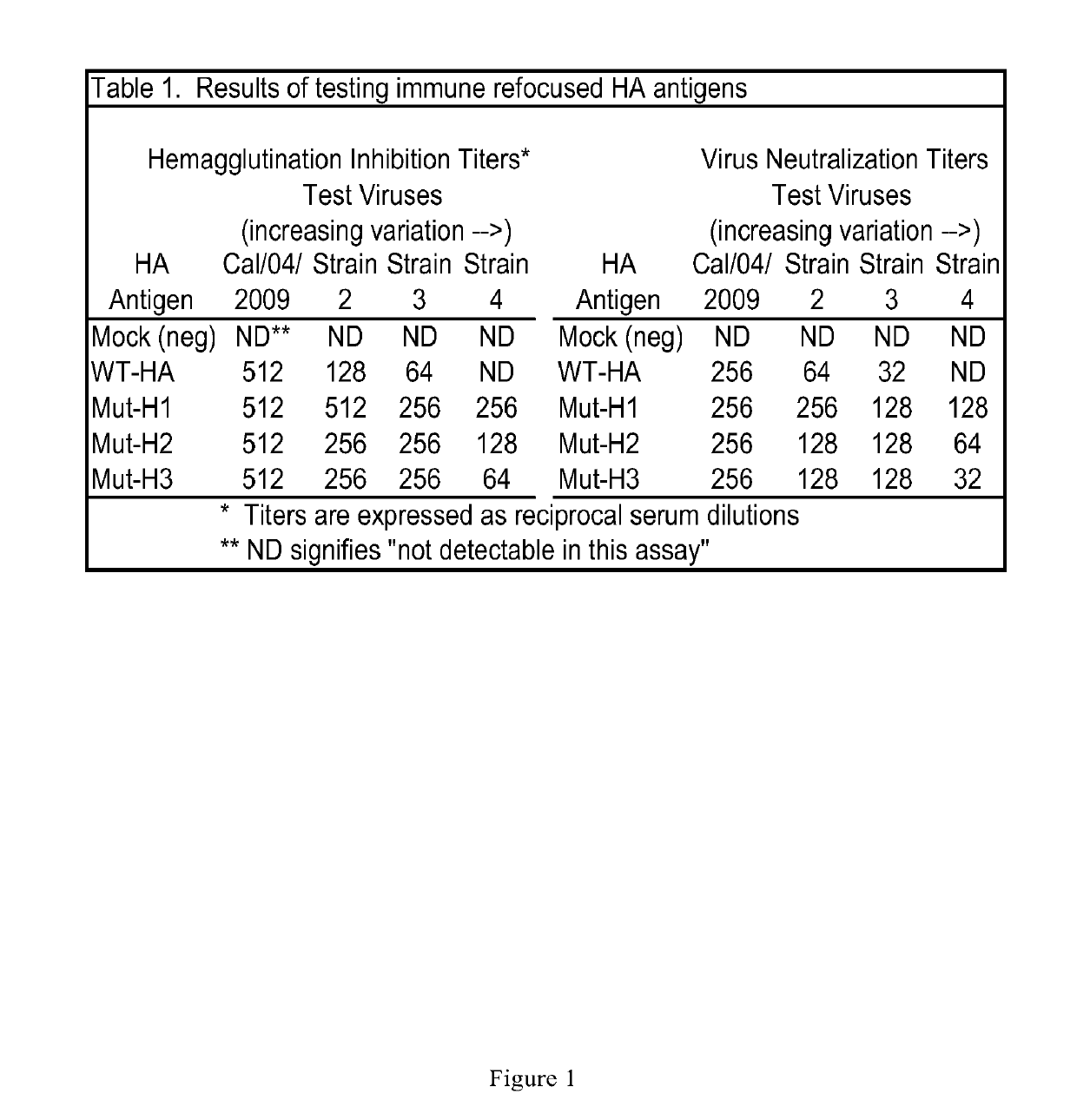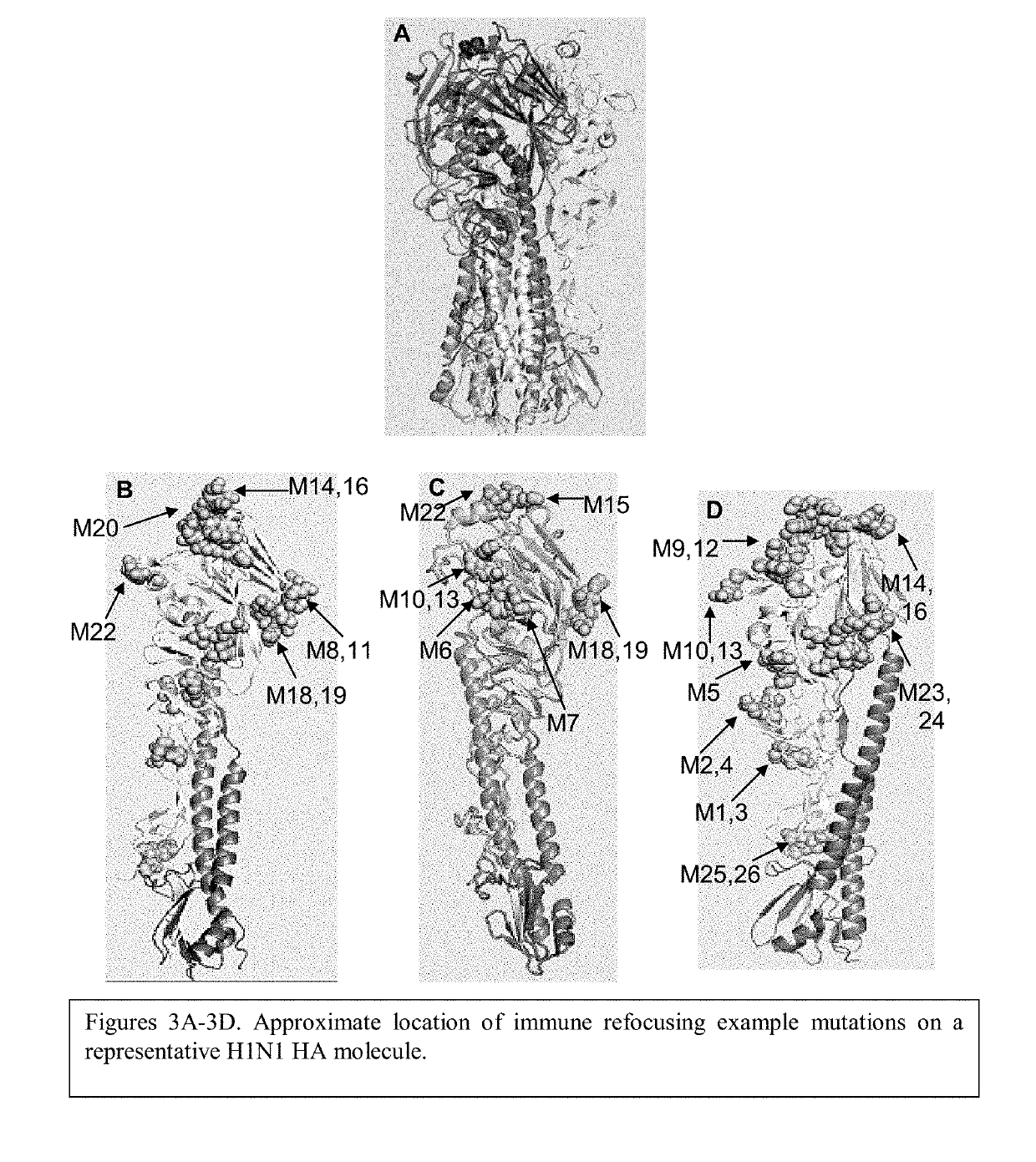Immunogenic influenza composition
a technology of composition and influenza, applied in the field of immunogenic influenza composition, can solve the problems of 111 million workdays lost, poor understanding of the fundamental laws governing the defense system of vertebrate hosts, and current vaccine technology that cannot be readily translated into new, broad-based effective and safe vaccines for humans, etc., and achieve the effect of improving or novel immunogenicity
- Summary
- Abstract
- Description
- Claims
- Application Information
AI Technical Summary
Benefits of technology
Problems solved by technology
Method used
Image
Examples
example 1
[0156]Eight immune dampened and refocused hemagglutinin genes derived from the Wyoming strain (H3N2) were designed and engineered as described above. For example, nucleotides were substituted by site-directed mutagenesis to introduce N-linked sequons leading to complex carbohydrate modifications, and / or deletions and / or charge changes of the amino acids into the five major immunogenic and highly variable sites containing the strain-specific epitopes.
[0157]Introduction of N-linked sequons was used to maximize the size of the immune dampening by each change, particularly in the larger antigenic sites while reducing the number of wild type amino acid changes required to dampen while minimizing any impact on the conformational complexity of the glycoprotein and receptor binding domain. In some cases, as few as three amino acid changes were needed. Antigenic Site B (187-196) targets both the B cell and CD4 helper T cell IDNPEs.
[0158]To expedite the study, both DNA and protein subunit vac...
example 2
[0171]The design of immune refocused hemagglutinin antigens of the swine-like H1N1v A / California / 04 / 2009 strain is based on multiple considerations, including analyses of immunodominant epitopes, evolution and sequence diversity and structural data. The following mutations are designed to refocus immune responses away from immunodominant, highly variable sites and toward more broadly protective epitopes.
[0172]As taught herein, immune refocusing mutations can take several forms including deletions, addition or subtraction of glycosylation sites as well as substitutions that affect charge, hydropathy, or some other chemical property of an epitope. Glycosylation additions have the advantage of masking epitopes with a relatively large moiety while charge changes focus on particular sites where antibody interacts with antigen. Because of the high degree of structural similarity among HA proteins of various influenza strains and serotypes, analysis of 3-D structures of the related A / PR8 / 3...
example 3
[0182]HA mutations can be engineered using, for example, known methods such as, site-specific mutagenesis (quick-change) or, for example, gene synthesis. In general, a quick-change mutation can be used for derivation of single or double mutations while gene synthesis can be used for more complex combinations.
[0183]Single-site mutations are most helpful in assessing immune refocusing techniques directed to specific residues of each epitope. However, because pathogens utilize more than one immunodominant, variable epitope (deceptive epitope or decotope) to evade long-term immune pressure, improved immune refocused antigens can incorporate mutations to multiple antigenic sites. Examples of immune refocused HA antigens containing mutations in 2 or 3 epitopes are provided in FIG. 4 which presents Table 3. Examples of immune refocused HA antigens containing mutations in all five epitopes are provided in FIG. 5 which presents Table 4. In both Tables 3 and 4, the mutations are comprised of ...
PUM
| Property | Measurement | Unit |
|---|---|---|
| time | aaaaa | aaaaa |
| time | aaaaa | aaaaa |
| time | aaaaa | aaaaa |
Abstract
Description
Claims
Application Information
 Login to View More
Login to View More - R&D
- Intellectual Property
- Life Sciences
- Materials
- Tech Scout
- Unparalleled Data Quality
- Higher Quality Content
- 60% Fewer Hallucinations
Browse by: Latest US Patents, China's latest patents, Technical Efficacy Thesaurus, Application Domain, Technology Topic, Popular Technical Reports.
© 2025 PatSnap. All rights reserved.Legal|Privacy policy|Modern Slavery Act Transparency Statement|Sitemap|About US| Contact US: help@patsnap.com



